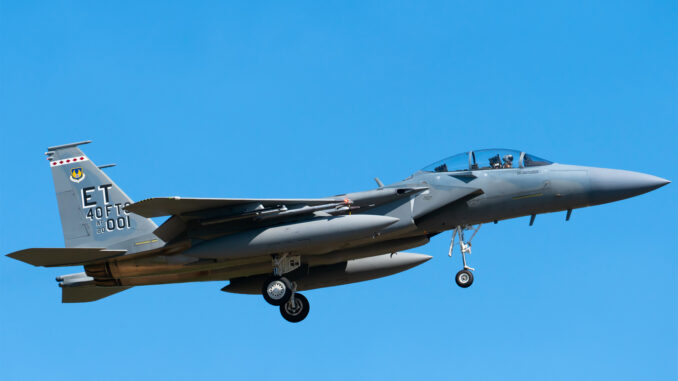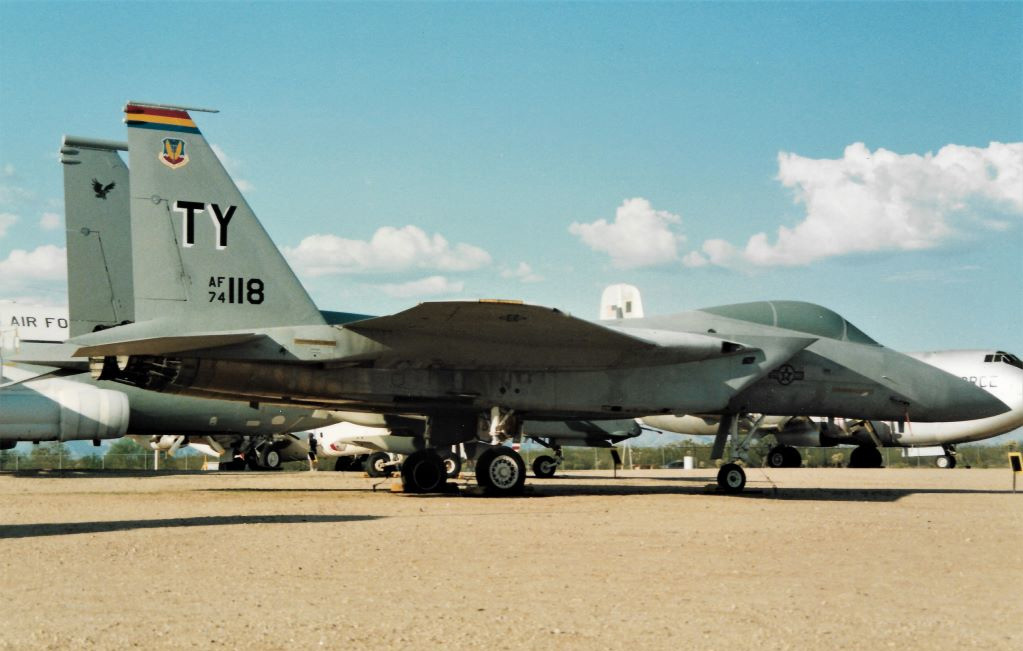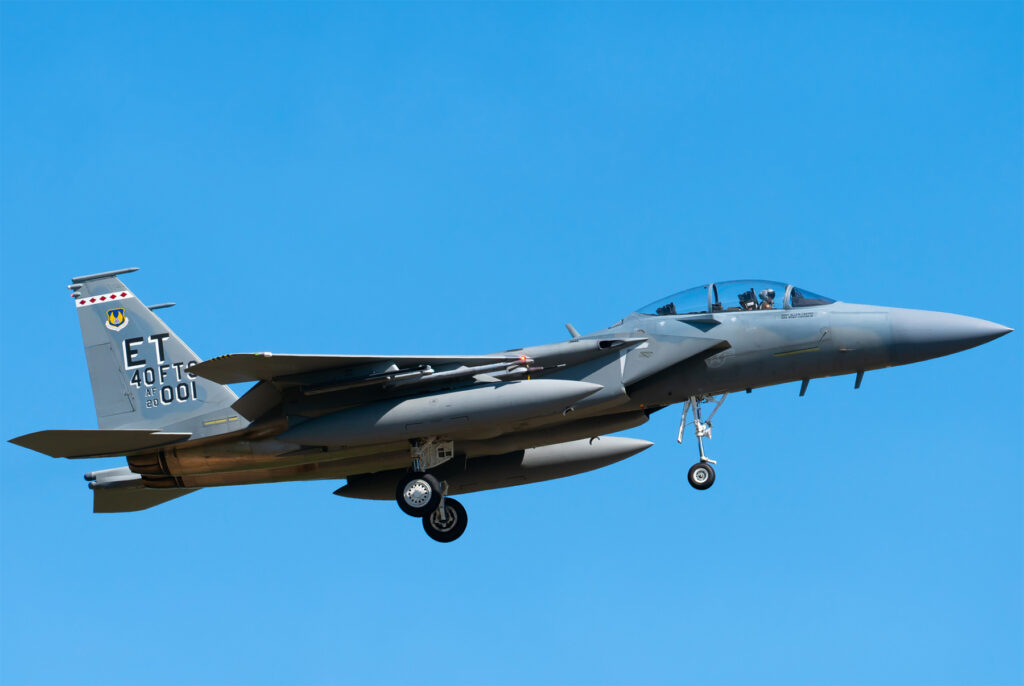
The Boeing F-15EX Eagle II: 12 missile carriage points, targeting accuracy, advanced defence mechanisms, long range and scalable architecture.
The F-15EX Eagle II is the latest version of the famous F-15 Strike Eagle, developed by Boeing to replace the older F-15s. Featuring 12 missile carriage points, precision targeting pods, advanced defence mechanisms and long-range firing capability, it represents a significant advance in air superiority. This 4.5th generation fighter is designed to offer a cost-effective alternative to the F-22 Raptors. It is scheduled to enter operational service in July. With an open mission architecture, it is designed to evolve rapidly in response to new threats and technologies.

12 missile carriage points
Carrying capacity and variety of weapons
The F-15EX Eagle II is equipped with 12 missile carriage points, 50% more than previous versions of the F-15. This increased capacity enables the F-15EX to carry a varied combination of weapons, including air-to-air missiles such as the AIM-9 Sidewinder, AIM-120 AMRAAM and AIM-260 JATM, as well as air-to-ground missiles such as the AGM-158 JASSM, AGM-88 HARM and AGM-183 ARRW. In terms of bombs, it can carry GBU-31 or GBU-38 JDAMs and GBU-39 Small Diameter Bombs.
In January 2023, the first examples of the F-15EX were used for payload demonstrations, highlighting their ability to effectively carry and launch these weapons. This ability to carry a wide variety of munitions considerably enhances the aircraft’s operational flexibility, enabling it to adapt to different combat missions, from air superiority to ground strikes.
Operational consequences
The ability to carry 12 missiles gives the F-15EX significant firepower, increasing its chances of success in complex engagements. It also reduces the need for frequent refuelling or rearmament missions, increasing the effectiveness of operations. For example, in an air-to-air engagement, the increased payload capacity enables the F-15EX to deal with multiple threats simultaneously, which is crucial in saturated combat environments.
High precision targeting pod
Target identification, tracking and guidance
The F-15EX is equipped with high-precision targeting pods, such as the Lockheed Martin AN/AAQ-33 Sniper XR and the Legion Pod with AN/ASG-34(V)1 IRST21 system. These systems provide precise target identification, tracking and guidance, offering exceptional combat reliability and increased accuracy at different flight altitudes.
The Sniper ATP, also used by the F-35, provides positive target identification, Global Positioning System (GPS) data generation and coordination, autonomous tracking and precise weapons guidance. These capabilities increase firing ranges, enabling long-range engagements while maintaining high accuracy, reinforcing the F-15EX’s air superiority over previous models.
Impact on combat missions
The integration of these targeting pods considerably improves the F-15EX’s ability to engage targets accurately, even at significant distances. This long-range firing capability is particularly useful in missions where stand-off distance is crucial, such as in heavily defended environments. For example, during a Suppression of Enemy Air Defences (SEAD) mission, the F-15EX can neutralise targets without exposing itself directly to enemy defence systems, thereby increasing crew safety and mission effectiveness.
Advanced defence mechanisms
Electronic Countermeasures Systems
The F-15EX features advanced defence systems, including the BAE Systems AN/ALQ-250 Eagle Passive Active Warning Survivability System (EPAWSS) and the AN/ALE-47 Airborne Countermeasures Dispenser System. These systems combine electronic warfare and electronic countermeasures to deceive radar, sonar and other detection systems by blocking the aircraft’s signatures and targeting information.
These innovative systems enable the F-15EX to maintain a state of low detectability while retaining maximum payload. By redefining the approach to electronic warfare, EPAWSS improves the survivability of the aircraft in highly contested environments by providing early warning and automatic countermeasures against threats.
Implications for combat survivability
The F-15EX’s advanced defence mechanisms significantly increase its ability to survive in hostile environments. For example, during a mission in enemy territory, electronic countermeasures systems can detect and neutralise potential threats before they become critical. This enables the F-15EX to carry out long-range missions without sacrificing safety, increasing its operational effectiveness in modern conflicts where threat environments are increasingly sophisticated.
Long-range firing capability
Firing performance and flight specifications
The F-15EX is designed for long-range engagements, with a combat range of 1,272 km and a maximum speed of Mach 2.5 (2,655 km/h) at high altitude. Its ferry range is 3,900 km with compliant fuel tanks and three external tanks. The service ceiling is 18,000 metres, with a load limit of +9 g and a climb rate of 250 metres per second.
These specifications enable the F-15EX to fire at longer ranges than any other USAF fighter, offering a significant strategic advantage. The combination of its speed, range and ability to carry a large payload make it a major asset for air superiority and deep attack missions.
Operational advantages
The F-15EX’s long-range firing capability enables it to carry out effective engagements while remaining out of range of enemy defence systems. For example, during a mission to suppress enemy air defences, the F-15EX can neutralise critical targets without entering the area of coverage of enemy surface-to-air missiles. This reduces the risks to the crew and increases the chances of mission success.

Scalable air superiority
Open mission architecture
The F-15EX features an open mission architecture, allowing rapid evolution in response to current combat requirements and global geopolitical situations. This flexibility enables the rapid integration of new technologies and upgrades to existing systems, ensuring that the F-15EX remains relevant in the face of emerging threats.
The F-15EX has impressive dimensions: a length of 19.446 metres, a wingspan of 13.045 metres and a height of 5.64 metres. Its empty weight is 15,694 kg, with a maximum take-off weight of 36,741 kg. It is powered by two General Electric F110-GE-129 afterburning turbojet engines, each with a thrust of 76.31 kN dry and 131 kN with afterburner.
Strategic advantages
The F-15EX’s open mission architecture allows for rapid and efficient modernization, which is essential to maintaining a strategic advantage. For example, if a new technological threat emerges, the F-15EX can be quickly equipped with appropriate countermeasures, ensuring its superiority on the battlefield. This ability to evolve quickly is crucial in a context of changing threats and constantly evolving technologies.
The Boeing F-15EX Eagle II represents a significant advance in air superiority, with its missile carriage capabilities, precision targeting systems, advanced defence mechanisms, long-range fire capability and open mission architecture. These characteristics make the F-15EX a major asset for the USAF, capable of meeting the challenges of modern combat and ensuring air superiority in the face of emerging threats.
War Wings Daily is an independant magazine.